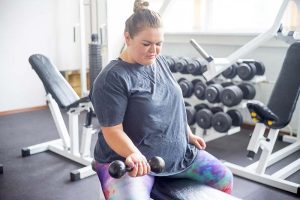Breast Cancer: Risk Factors and Preventative Measures
Author: Lucas Tims, ND, FABNO
Survivors, family members, friends, and even football teams sport the color pink during the month of October in an effort to raise awareness for breast cancer. Not only is it the most common type of cancer in women, but it’s also the leading cause of female cancer deaths.
You probably haven’t given breast cancer much thought unless you yourself or someone close to you has been diagnosed. However, with a 1 in 8 chance that a woman will develop breast cancer in her lifetime, it may be time to take notice. This trend is very alarming and it’s important to understand the risk factors and steps you can take toward breast cancer prevention.
 Early detection matters, but mammograms aren’t the only option
Early detection matters, but mammograms aren’t the only option
Conventional medicine has recommended the mammogram as a breast cancer screening tool for years. While mammograms have been shown to make a difference in some populations, there are risks involved because of radiation exposure and the possibility of false positives. When false positives occur, it can result in unnecessary biopsies, overtreatment, and of course unnecessary stress and fear.
There are some newer early detection methods that show a lot of promise. One being full body MRI’s that don’t involve radiation or contrast agents. They are a more sensitive and are a more specific screening method with a lower risk of false positives. These methods aren’t FDA approved yet, but I do believe they will be widely used in the future.
Another tool, that the Riordan Clinic uses, is thermography. Thermography uses an infrared camera to detect subtle variations of heat radiating from the surface of the body. The heat variations can be an indicator of infection, inflammation or presence of cancer cells. It’s important to note that thermography is not a diagnostic tool, but it may pick up on early signs of cancer growth. However, I don’t typically rely on thermography results alone to determine if someone is in the clear. Things such as blood markers, self-exam results, and personal risk factors must also be considered alongside thermography.
Prevention before detection
A lot of emphasis is placed on early detection, but there is little talk about prevention. It’s like how back in the day smokers were encouraged to get regular chest x-rays to rule out lung cancer. Yet, there was no mention of quitting smoking. This approach simply doesn’t make sense. Women need to think proactively about things like diet, exercise, sleep, environmental exposures, and the like. There are several low-cost, everyday actions you can take to lower your risk of developing breast cancer.
Eat real food, and lots of plants
When it comes to diet, it is best to avoid processed food, added or refined sugars, and eating organic whenever possible. It’s important to load up on phytonutrients, which are the natural compounds found in plant foods.
These nutrients help repair our DNA on a daily basis, which is essential for long-lasting health. Tumors form when you’ve gone way too long without repairing the DNA of the cells in a certain part of the body. We are almost constantly undergoing DNA damage and mitochondrial dysfunction that leads to that DNA damage. However, if you can withstand a certain amount of damage and your diet and lifestyle allow for that repair to happen, it may not have as big an impact on your health or lead to tumor development.
Reduce your chemical exposure
Chemical exposure can also be a major contributor to the development of breast cancer because of the impact certain chemicals have on hormones, including estrogen that can enhance cancer growth. Plastics, pesticides, and many of the chemicals found in personal care items that are used every single day are just a few examples of chemical exposures and endocrine disruptors that most women encounter on a regular basis.
You can begin to reduce your exposure, but chemicals will always be around. Luckily, there are other practices that can help the body’s natural detoxification mechanisms. Focus on movement – move your body, move your blood, and move your bowels to help facilitate proper detoxification. Regular exercise is one of the easiest ways to make this happen. Other things like sauna and lymphatic massage can also be helpful.
Rethink your birth control
Progestins are synthetic forms of the hormone progesterone that is naturally produced in a woman’s body. Many birth control pills and some hormone replacement drugs contain progestins. Some studies are linking progestins and breast cancer. While the research isn’t conclusive, it may be one risk factor you can eliminate by replacing your birth control or hormone replacement with a different form.
 Manage your metabolism
Manage your metabolism
Being overweight is a big risk factor for breast cancer and there are other complications that can arise as a result of having excess body fat. Furthermore, if a woman is in the pre-diabetic or diabetic range, insulin rises and can act as fuel for cancer cells.
Nearly half of the U.S. population is considered obese and once people get to that state it can be very tough to reverse. It often requires some pretty drastic diet and lifestyle changes. It’s not always the food you are eating that contributes to the problem, but chemicals, endocrine disruptors, carcinogens affect on metabolic health, and the body’s ability to store and utilize calories and nutrients. The extra fat then houses some of these toxins and essentially becomes its own chemical factory, creating a vicious cycle.
Taking steps to eat better, exercise, and detoxify are essential if you are a woman carrying excess weight. Working with a health coach or a personal trainer along with your medical provider can help you stay motivated.
Get Your Vitamin D
Low Vitamin D levels are a common characteristic of many women diagnosed with breast cancer and there are certain populations of women who are prone to deficiency. Women who are overweight have higher Vitamin D requirements, and women from ethnicities with darker skin are at higher risk for Vitamin D deficiency. Our bodies make Vitamin D naturally with adequate sun exposure, but most of us spend a lot of time indoors, especially in the winter. Supplementing with Vitamin D is an easy way to make sure your levels are in the preventative range. Our Vitamin D3/K2 supplement is one I recommend to a lot of my patients.
Throw everything at it
When it comes to prevention, the more you can do the better. If you can improve your diet, exercise, detox regularly, and lower your stress levels the compound effect is greater than just doing one of those things. However, starting with one is better than nothing at all. If you feel that you are at a particularly high risk for breast cancer, then a more aggressive plan may be necessary. Working with a provider to help guide you and determine the highest priorities will make it easier than trying to figure it all out on your own.
The main takeaways I want to emphasize are that there are a lot of things that you can control to help lower your risk of developing breast cancer and prevention is just as important (if not more!) as detection.





